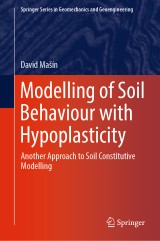Details

Modelling of Soil Behaviour with Hypoplasticity
Another Approach to Soil Constitutive ModellingSpringer Series in Geomechanics and Geoengineering
|
149,79 € |
|
| Verlag: | Springer |
| Format: | |
| Veröffentl.: | 12.12.2018 |
| ISBN/EAN: | 9783030039769 |
| Sprache: | englisch |
Dieses eBook enthält ein Wasserzeichen.
Beschreibungen
<p>This book explains the hypoplastic modelling framework. It is divided into two parts, the first of which is devoted to principles of hypoplasticity. First, the basic features of soil’s mechanical behaviour are introduced, namely non-linearity and asymptotic properties. These features are then incorporated into simple one-dimensional hypoplastic equations for compression and shear. Subsequently, a hypoplastic equivalent of the Modified Cam-Clay model is developed in 2D space using stress and strain invariants to demonstrate key similarities and differences between elasto-plastic and hypoplastic formulations. Lastly, the mathematical structure of hypoplastic models is explained by tracing their historical development, from the early trial-and-error models to more recent approaches. In turn, Part II introduces specific hypoplastic models for soils. First, two reference models for sand and clay are defined. After summarising their mathematical formulations, calibration procedures are described and discussed. Subsequently, more advanced modelling approaches are covered: the intergranular strain concept incorporating the effects of small strain stiffness and cyclic loading, viscohypoplasticity for predicting rate effects, soil structure to represent structured and bonded materials and soil anisotropy. The book concludes with a description of partial saturation and thermal effects: topics that are increasingly important to the disciplines of energy and environmental geotechnics.</p>
Selecting a constitutive model and its parameters is often the most important and yet challenging part of any numerical analysis in geotechnical engineering. Hypoplasticity involves a specific class of soil constitutive models, which are described in detail here. The book offers an essential resource, both for model users who need a more advanced model for their geotechnical calculations and are mainly interested in parameter calibration procedures, and for model developers who are seekinga comprehensive understanding of the mathematical structure of hypoplasticity.<br>
Selecting a constitutive model and its parameters is often the most important and yet challenging part of any numerical analysis in geotechnical engineering. Hypoplasticity involves a specific class of soil constitutive models, which are described in detail here. The book offers an essential resource, both for model users who need a more advanced model for their geotechnical calculations and are mainly interested in parameter calibration procedures, and for model developers who are seekinga comprehensive understanding of the mathematical structure of hypoplasticity.<br>
<p>This book explains the hypoplastic modelling framework. It is divided into two parts, the first of which is devoted to principles of hypoplasticity. First, the basic features of soil’s mechanical behaviour are introduced, namely non-linearity and asymptotic properties. These features are then incorporated into simple one-dimensional hypoplastic equations for compression and shear. Subsequently, a hypoplastic equivalent of the Modified Cam-Clay model is developed in 2D space using stress and strain invariants to demonstrate key similarities and differences between elasto-plastic and hypoplastic formulations. Lastly, the mathematical structure of hypoplastic models is explained by tracing their historical development, from the early trial-and-error models to more recent approaches. In turn, Part II introduces specific hypoplastic models for soils. First, two reference models for sand and clay are defined. After summarising their mathematical formulations, calibration procedures are described and discussed. Subsequently, more advanced modelling approaches are covered: the intergranular strain concept incorporating the effects of small strain stiffness and cyclic loading, viscohypoplasticity for predicting rate effects, soil structure to represent structured and bonded materials and soil anisotropy. The book concludes with a description of partial saturation and thermal effects: topics that are increasingly important to the disciplines of energy and environmental geotechnics.</p>
Selecting a constitutive model and its parameters is often the most important and yet challenging part of any numerical analysis in geotechnical engineering. Hypoplasticity involves a specific class of soil constitutive models, which are described in detail here. The book offers an essential resource, both for model users who need a more advanced model for their geotechnical calculations and are mainly interested in parameter calibration procedures, and for model developers who are seekinga comprehensive understanding of the mathematical structure of hypoplasticity.<br>
Selecting a constitutive model and its parameters is often the most important and yet challenging part of any numerical analysis in geotechnical engineering. Hypoplasticity involves a specific class of soil constitutive models, which are described in detail here. The book offers an essential resource, both for model users who need a more advanced model for their geotechnical calculations and are mainly interested in parameter calibration procedures, and for model developers who are seekinga comprehensive understanding of the mathematical structure of hypoplasticity.<br>
Explains the hypoplastic model structure Introduces readers to specific hypoplastic models for soils, with a focus on two particular models: models for sand and models for clay An essential resource, both for practitioners using the models in their geotechnical calculations and for model developers
Diese Produkte könnten Sie auch interessieren:

Water Quality Hazards and Dispersion of Pollutants

von: Wlodzimierz Czernuszenko, Pawel Rowinski

149,79 €















